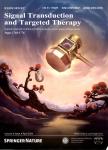cBAF and MYC:decision makers for T cell memory differentiation
作者机构:CAMS Key Laboratory of Synthetic Biology Regulatory ElementInstitute of Systems MedicineChinese Academy of Medical Sciences and Peking Union Medical College100005BeijingChina Suzhou Institute of Systems MedicineSuzhou215123JiangsuChina Jiangsu Center for the Collaboration and Innovation of Cancer BiotherapyCancer InstituteXuzhou Medical UniversityXuzhouChina
出 版 物:《Signal Transduction and Targeted Therapy》 (信号转导与靶向治疗(英文))
年 卷 期:2023年第8卷第1期
页 面:1-2页
核心收录:
学科分类:1002[医学-临床医学] 100214[医学-肿瘤学] 10[医学]
基 金:supported by the National Natural Science Foundation of China(81971466,32100724) the Natural Science Foundation Outstanding Youth Fund of Jiangsu Province(BK20220049) PUMC Fundamental Research Funds for the Central Universities(3332021073) CAMS Innovation Fund for Medical Sciences(CIFMS 2021-I2M-1-047,CIFMS 2021-I2M-1-061)
摘 要:In a recent paper published in Nature,Guo et al.1 demonstrated that asymmetrically segregated MYC and canonical BRG1/BRM-associated factor(cBAF)at first division of activated CD8^(+)T cells cooperate to dictate T cell fate by remodeling of epigenetics and chromatin *** pharmacological or genetic inhibition of cBAF in chimeric antigen receptor T(CAR-T)cells considerably promotes their anti-tumor capacity in vivo,presumably by biased memory differentiation post transfer(Fig.1).



